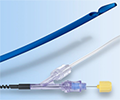Clinical articles
January 2019 Br J Cardiol 2019;26:27–30 doi :10.5837/bjc.2019.004
Outcome of investigations into patients who attended the emergency department due to palpitations
Alexander J Gibbs, Andrew Potter
| Full textJanuary 2019 Br J Cardiol 2019;26:35 doi :10.5837/bjc.2019.005
Association of subclinical hypothyroidism in heart failure: a study from South India
Pramod Kumar Kuchulakanti, VCS Srinivasarao Bandaru, Anurag Kuchulakanti, Tallapaneni Lakshumaiah, Mehul Rathod, Rajeev Khare, Parsa Sairam, Poondru Rohit Reddy, Athuluri Ravikanth, Avvaru Guruprakash, Regalla Prasada Reddy, Banda Balaraju
| Full textJanuary 2019 Br J Cardiol 2019;26:36–7 doi :10.5837/bjc.2019.006
Significant suppression of premature ventricular ectopics with ivabradine in dilated cardiomyopathy
Lal H Mughal, Andrew R Houghton, Jeffrey Khoo
| Full textDecember 2018 Br J Cardiol 2018;25:140–2 doi :10.5837/bjc.2018.031
Quality of life in postural orthostatic tachycardia syndrome (PoTS): before and after treatment
Toby Flack, Jamie Fulton
| Full text
December 2018 Br J Cardiol 2018;25:152–6 doi :10.5837/bjc.2018.032
Thrombus aspiration in primary percutaneous coronary intervention: to use or not to use?
Telal Mudawi, Mohamed Wasfi, Darar Al-Khdair, Muath Al-Anbaei, Assem Fathi, Nikolay Lilyanov, Mohammed Elsayed, Ahmed Amin, Dalia Besada, Waleed Alenezi, Waleed Shabanh
| Full textDecember 2018 Br J Cardiol 2018;25:159–60 doi :10.5837/bjc.2018.033
Percutaneous endovascular repair of congenital interruption of the thoracic aorta
Richard Armstrong, Kevin Walsh, David Mulcahy
| Full text
October 2018 Br J Cardiol 2018;25:147–9 doi :10.5837/bjc.2018.026
Transitions of an open-heart surgery support lab in a resource-limited setting: effect on turnaround time
Ijeoma Angela Meka, Williams Uchenna Agu, Martha Chidinma Ndubuisi, Chinenye Frances Onyemeh
| Full text
October 2018 Br J Cardiol 2018;25:150–1 doi :10.5837/bjc.2018.027
Utility of MPS in AAA repair and prognostication of cardiovascular events and mortality
Mark G MacGregor, Neil Donald, Ayesha Rahim, Zara Kwan, Simon Wong, Hannah Sharp, Hannah Burkey, Mark Fellows, David Fluck, Pankaj Sharma, Vineet Prakash, Thang S Han
| Full textOctober 2018 Br J Cardiol 2018;25:143–6 doi :10.5837/bjc.2018.028
New-onset giant T-wave inversion with prolonged QT interval: shared by multiple pathologies
Debjit Chatterjee, Priya Philip, Kay Teck Ling
| Full textOctober 2018 Br J Cardiol 2018;25:157–8 doi :10.5837/bjc.2018.029
A case report of transient acute left ventricular dysfunction
Allam Harfoush
| Full text
